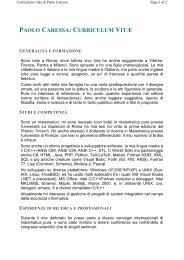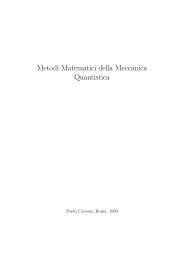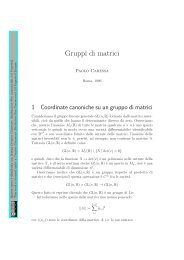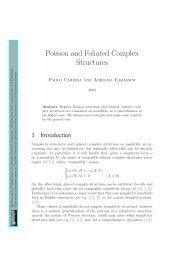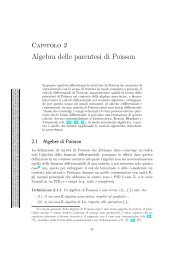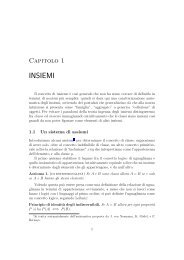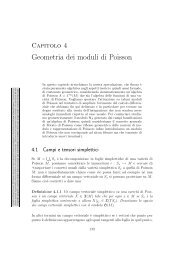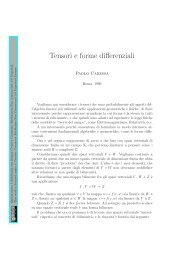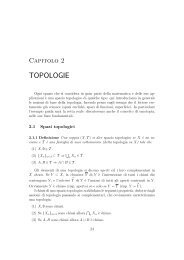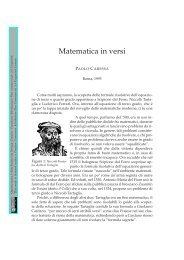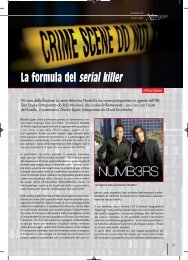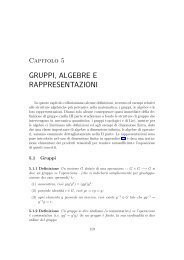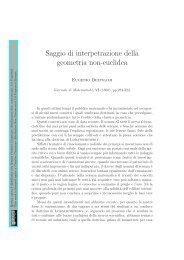You also want an ePaper? Increase the reach of your titles
YUMPU automatically turns print PDFs into web optimized ePapers that Google loves.
<strong>Strutture</strong> <strong>di</strong> <strong>Poisson</strong> 39ove (y 0 = √ 1−y 2 1 −y 2 2 −y 2 3,y 1 ,y 2 ,y 3 ) sono le coor<strong>di</strong>nate <strong>di</strong> y. Il valore dellefunzioni x i ◦L y e x i ◦R y è facilmente determinato su un generico punto x ∈SU(2) considerando x e y come matrici, effettuando il prodotto matriciale epoi prendendo la coor<strong>di</strong>nata reale x i della matrice prodotto. In modo analogosi ottieneπ 13 (y) = π y (dx 1 ∧dx 3 ) = y 0 y 3 π 23 (y) = π y (dx 2 ∧dx 3 ) = 0con il che il tensore π è totalmente determinato. Avendo a <strong>di</strong>sposizione lesue componenti si verifica imme<strong>di</strong>atamente, usando la con<strong>di</strong>zione <strong>di</strong> Lie, cheπ è un tensore <strong>di</strong> <strong>Poisson</strong>. Possiamo anche constatare senza <strong>di</strong>fficoltà che πverifica la con<strong>di</strong>zione <strong>di</strong> 1-cociclo:π xy = (dR xy −dL xy )X 2 ∧X 3= (dR xy −d(R y L x )+d(L x R y )−dL xy )X 2 ∧X 3= (dR y dR x −dR y dL x +dL x dR r −dL x dL y )X 2 ∧X 3= dR y π x +dL x π yQuin<strong>di</strong> abbiamo <strong>di</strong>mostrato che π rende SU(2) un gruppo <strong>di</strong> Lie–<strong>Poisson</strong>.Ve<strong>di</strong>amo ora come questa struttura <strong>di</strong> <strong>Poisson</strong> si riverbera sull’algebra <strong>di</strong> Liesu(2). Consideriamo lo spazio duale su(2) ∗ ; dato che il gruppo <strong>di</strong> Lie SU(2) èunavarietà<strong>di</strong><strong>Poisson</strong>sappiamochequestospazio èun’algebra<strong>di</strong>Lie,rispettoalle parentesi:[dx i ,dx j ] = d{x i ,x j } =(∂πij∂x 1)Idx 1 +(∂πij∂x 2)Idx 2 +(∂πijAllora le costanti <strong>di</strong> struttura dell’algebra <strong>di</strong> Lie su(2) ∗ sono leA conti fatti si ottengono i valorif ijk := (∂πij∂x k)If 12k = δ k2 f 13k = δ k3 f 23k = 0∂x 3)IUtilizzando quin<strong>di</strong> la (2) del teorema <strong>di</strong> Drinfeld–Manin è imme<strong>di</strong>ato verificareche su(2) è una bialgebra <strong>di</strong> Lie, e precisamente, tram<strong>it</strong>e la corrispondenzaseguente fra gli elementi della sua base associata alle coor<strong>di</strong>nate {x i }:dx 1 ↔( )1√200 −√ 12( 01)√2dx 2 ↔0 0dx 3( 0i)√dx 3 ↔ 20 0




